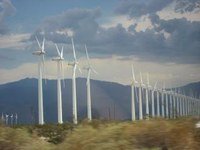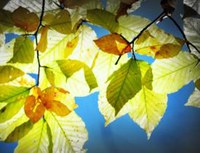Wildland fire
Wildland fire is a natural component of Appalachian ecosystems—rare in some landscapes and more frequent in others. Its effects are complex and often beneficial to ecosystem processes. However, dramatic changes in landscape characteristics resulting from human activities, including the suppression of natural fire, have changed the frequency and severity of fires in such a way that modern fire regimes can sometimes have negative effects on ecosystem services.
The impacts of fire interact with other drivers of landscape change in important ways. Climate change will continue to influence the frequency, size, and severity of wildland fires throughout the United States. These changes are expected to be less severe in the Appalachians than in other regions, but the western Appalachians may experience increased fire risk with warmer and drier future conditions. Interactions with urbanization may be more significant: most Appalachian wildfires are ignited by people, and the risk of fire increases as roads, housing, and growing populations increasingly interface with wildlands.
Water and soils — Wildland fires of sufficient intensity can increase soil erosion and sediment loads in streams, and can alter soil and water chemistry in the short term, particularly in forests of the western United States. However, most fires studied in Appalachian forests have not shown large impacts of this kind, and documented impacts have typically been followed by rapid recovery to pre-fire conditions. Impacts are likely to be greater for single, intense fires after long periods of fuel build-up than for several low-intensity fires at semi-regular intervals. This suggests that fire suppression can enhance the likelihood of fires with negative water and soil impacts, whereas prescribed fires typically have little negative effect.
Timber and nontimber forest products — Wildland fire in eastern forests is typically not intense enough to have strong negative impacts on timber productivity or quality. Natural fire has been important over the long term in helping to maintain commercially valuable Appalachian forest types, particularly upland hardwood stands. Fire suppression has resulted in declines of species—such as the oaks—that are important in these forests, replaced by faster-growing species that compete well in the absence of fire. When used appropriately, prescribed fire can be an effective tool for managing upland hardwoods and other fire-associated ecosystems that sustain forest product production and utilization.
Carbon storage — Wildland fire releases carbon dioxide, the most important greenhouse gas, into the atmosphere. Conversely, forest regrowth after fire captures and stores carbon over longer time scales. Thus, fire is one driver of forest carbon cycling. The overall contribution of fire regimes to long-term forest carbon balances is not well understood, especially in eastern upland forests where fire is relatively infrequent.
Rural landscape values and outdoor recreation — There are significant management challenges related to the cost and social perceptions of wildland fire, and of activities such as prescribed burning and fuel treatments. People living in and near lands affected by fire may be exposed to significant risk, especially in terms of the dangers of uncontrolled fire to lives and property, but also in terms of health and safety risks associated with smoke and ash. Burning activities and recently burned landscapes may also be perceived negatively by outdoor recreation enthusiasts and others seeking to enjoy forest landscapes, even while the longer-term effects of fire can result in aesthetically and ecologically desirable forest conditions. Difficult trade-offs in terms of the timing and location of different activities will be necessary to "live with fire" and maintain a variety of compatible ecosystem services in fire-prone landscapes.
References
Brose, P., D. C. Dey, and T. A. Waldrop. 2014. The Fire-Oak Literature of Eastern North America: Synthesis and Guidelines. Gen. Tech. Rep. NRS-135. USDA Forest Service, Northern Research Station: 98 pp.
Brose, P., T. Schuler, D. Van Lear, and J. Berst. 2001. Bringing fire back: the changing regimes of the Appalachian mixed-oak forests. Journal of Forestry 99: 30-35.
Brose, P. H., D. C. Dey, R. J. Phillips, and T. A. Waldrop. 2013. A meta-analysis of the fire-oak hypothesis: does prescribed burning promote oak reproduction in eastern North America? Forest Science 59(3): 322-334.
Coulston, J. W., D. N. Wear, and J. M. Vose. 2015. Complex forest dynamics indicate potential for slowing carbon accumulation in the southeastern United States. Scientific Reports 5: 8002.
Downey, D. M., J. P. Haraldstatdt, and S. N. Fisher. 2014. Water chemistry of North Branch Simpson Creek and the Rich Hole Wilderness fire, 113-126. In T. A. Waldrop, editor, Proceedings: Wildland Fire in the Appalachians: Discussions Among Managers and Scientists. Gen. Tech. Rep. SRS-199. USDA Forest Service, Southern Research Station: 208 pp.
Keyser, T., J. Malone, C. Cotton, and J. Lewis. 2014. Outlook for Appalachian-Cumberland forests: a subregional report from the Southern Forest Futures Project. General Technical Report SRS-GTR-188. USDA Forest Service, Southern Research Station: 83 pp.
Liu, Y., J. P. Prestemon, S. L. Goodrick, T. P. Holmes, J. A. Stanturf, J. M. Vose, and G. Sun. 2014. Future wildfire trends, impacts, and mitigation options in the southern United States, 85-126. In J. M. Vose and K. D. Klepzig, editors, Climate Change Adaptation and Mitigation Management Options: A Guide for Natural Resource Managers in Southern Forest Ecosystems. CRC Press: 492 pp.
McNulty, S., P. Caldwell, T. W. Doyle, K. Johnsen, Y. Liu, J. Mohan, J. Prestemon, and G. Sun. 2013. Forests and climate change in the southeast USA, 165-189. In K. Ingram, K. Dow, L. Carter, and J. Anderson, editors, Climate of the Southeast United States: Variability, change, impacts, and vulnerability. Island Press: 341 pp.
Peters, M. P., L. R. Iverson, S. N. Matthews, and A. M. Prasad. 2013. Wildfire hazard mapping: exploring site conditions in eastern US wildland-urban interfaces. International Journal of Wildland Fire 22: 567-578.
Southern Appalachian Man and the Biosphere (SAMAB). 1996. The Southern Appalachian Assessment Terrestrial Technical Report. Report 5 of 5, USDA Forest Service, Southern Region: 248 pp.
Stanturf, J. A., and S. L. Goodrick. 2013. Fire, 509-542. In D. N. Wear and J. G. Greis, editors, The Southern Forest Futures Project: Technical Report. Gen. Tech. Rep. SRS-178, USDA Forest Service, Southern Research Station: 542 pp.
U.S. Department of Agriculture Forest Service. 2012. Future of America's Forests and Rangelands: Forest Service 2010 Resources Planning Act Assessment. Gen. Tech. Rep. WO-87. USDA Forest Service: 198 pp.
Vose, J. M., W. T. Swank, B. D. Clinton, J. D. Knoepp, and L. W. Swift. 1999. Using stand replacement fires to restore southern Appalachian pine–hardwood ecosystems: effects on mass, carbon, and nutrient pools. Forest Ecology and Management 114: 215-226.



![Hemlock Wooly Adelgid By Nicholas A. Tonelli from Pennsylvania, USA (Henry's Woods (6)) [CC BY 2.0 (http://creativecommons.org/licenses/by/2.0)], via Wikimedia Commons](https://landscapepartnership.org/ecosystem-risks-benefits/risks/hemlock-wooly-adelgid/@@images/b0bf0bc4-1b53-4b20-8e38-e82d344bee8c.jpeg)

![Wildfires in Eastern U.S. By Glenn Research Center (https://www.dvidshub.net/image/857727) [Public domain], via Wikimedia Commons](https://landscapepartnership.org/ecosystem-risks-benefits/risks/wildfires-in-eastern-u.s/@@images/0d2bbb65-9ef4-4070-a99f-c36b403f71cf.jpeg)




















